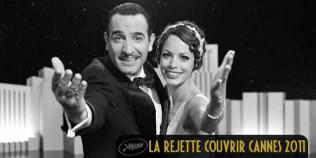
Strictly speaking Mr. Hazanavicius’s film is not a silent movie. There is a lot of music on the soundtrack and also a few strategic moments of onscreen noise that are both delightfully surprising and wildly illogical. The whole conceit of the picture is spun in willful disregard of the laws governing time, space and sound, an embrace of the preposterous that is perhaps more reminiscent of the spirit of early French cinema than of the old Hollywood where the action takes place.
In those days the sign up in the hills said HOLLYWOODLAND, and the screens were dominated by antic clowns, pale heroines and dashing lovers. George Valentin (Jean Dujardin, the star of the popular “OSS 117” series of French spy spoofs, also directed by Mr. Hazanavicius) undoubtedly belongs in that last category. With his shiny hair, radiant teeth and thin mustache — and a surname one vowel short of Valentino — George is a quintessential movie star.
The public adores him, and he is far too gracious an entertainer to contradict them. A carefree narcissist, he bounces from the studio lot to the red carpet to the Beverly Hills mansion he shares with his devoted dog and less enchanted wife and co-star (Penelope Ann Miller), secure in the permanence of his glory.
Even viewers entirely innocent of film history — even the young, blockbuster-fed movie fans who find themselves dragged to and then transported by this minor marvel — will anticipate what happens next. George’s pride sets up a fall, first into a sweet, awkward infatuation with an aspiring actress named Peppy Miller (Bérénice Bejo), then into professional ruin brought about by his stubborn refusal to change with the times. Abandoned by his wife and shunned by the studio boss (a wonderfully boisterous John Goodman), with only the dog and his chauffeur (James Cromwell) standing by him, the star goes into eclipse. But even when threatened with the torments of obscurity, he refuses to speak.
The rise of the talkies has almost always been chronicled on film from the perspective of sound. It could hardly have been otherwise. “Singin’ in the Rain,” with its exuberant music and bright colors, does not so much revisit the old splendor of cinema silence as obliterate its memory, much as “Sunset Boulevard” unlocks a world of ghosts and shadows among the remnants of the faded Hollywood pantheon. “The Artist,” as aggressively entertaining as any musical, is measured in its mourning and eclectic in its nostalgia for old movies. There is a bit of music lifted from Bernard Herrmann’s “Vertigo” score, a breakfast-table montage inspired by “Citizen Kane” and a story line that makes “The Artist,” in essence, the latest (and also in a way the earliest, but surely not the last) remake of “A Star Is Born.”
All of this suggests a feast for antiquarian film geeks. It certainly is, and Mr. Hazanavicius’s skill in replicating some of the visual effects of early cinema is impressive. But he evokes the glamour and strangeness of silent movies without entirely capturing the full range of their power. His film is less a faithful reproduction than a tasteful updating, like a reconstituted classic roadster with a GPS device and a hybrid engine.
Still, it is a smooth and very exciting ride. If “The Artist” revels in gimmickry and occasionally oversells its charm, it also understands the deep and durable fascination of the art it embraces. Like Martin Scorsese in “Hugo,” another modern-day journey into a dream of the movie past, Mr. Hazanavicius knows that the audience’s pleasure arises at once from the complex displays of craft in the service of simple, direct effects. We like to be dazzled by the whirring, kinetic machinery, thrilled by the conjuring of what should be impossible and swept away on currents of pure and powerful feeling.
Mr. Hazanavicius accomplishes this with not only showy ambition but also a winning modesty that grows out of an appreciation that popular art is, above all, about the efficient and inventive delivery of fun. Its techniques are impressive and various, though its most persuasive special effects are Mr. Dujardin and Ms. Bejo, physically graceful performers with faces the camera cannot resist. He has a solid athleticism that meshes perfectly with her supple, long-limbed grace, and their features are at once iconic and lively, in the manner of the ancient movie stars to whom they pay tribute.
Thanks in no small part to their expressiveness and dexterity — they dance beautifully and also portray emotion with just the right blend of naturalism and melodramatic exaggeration — “The Artist” is more than a clever pastiche of antique amusements. It may be something less than a great movie, but it is an irresistible reminder of nearly everything that makes the movies great.
“The Artist” is rated PG-13 (Parents strongly cautioned). A few scary moments, an obscene gesture and a lot of smoking.
nytimes.com




